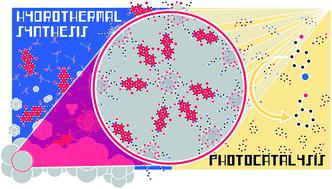当前位置:
X-MOL 学术
›
J. Mater. Chem. A
›
论文详情
Our official English website, www.x-mol.net, welcomes your
feedback! (Note: you will need to create a separate account there.)
Green hydrothermal synthesis yields perylenebisimide–SiO2 hybrid materials with solution-like fluorescence and photoredox activity
Journal of Materials Chemistry A ( IF 10.7 ) Pub Date : 2022-06-13 , DOI: 10.1039/d1ta03214c Hipassia M Moura 1, 2 , Herwig Peterlik 3 , Miriam M Unterlass 1, 2
Journal of Materials Chemistry A ( IF 10.7 ) Pub Date : 2022-06-13 , DOI: 10.1039/d1ta03214c Hipassia M Moura 1, 2 , Herwig Peterlik 3 , Miriam M Unterlass 1, 2
Affiliation

|
In organic–inorganic hybrid materials' (HMs) synthesis, it is intrinsically challenging to, at the same time, achieve (i) the concomitant synthesis of the components, (ii) nanoscopic interpenetration of the components, and (iii) covalent linking of the components. We here report the one-pot hydrothermal synthesis (HTS) of inorganic–organic HMs consisting of perylene bisimide (PBI) dyes and silica, using nothing but water as the medium and directly from the corresponding bisanhydrides, n-alkyl amines, and alkoxysilane precursors. First, in the absence of a functionalized alkoxysilane for linking, a mixture of the products, PBI and SiO2, is obtained. This evinces that the two products can be synthesized in parallel in the same vessel. Except for minor micromorphological changes, the concomitant synthesis does not affect each component's physicochemical properties. The PBI/SiO2 mixtures do not show synergistic properties. Second, through adding the linker aminopropyltriethoxysilane (APTS), covalently-linked class II hybrids are obtained. These PBI@SiO2 class II hybrids show synergistic materials properties: increased thermal stability is obtained in combination with nanoscopic homogeneity. The PBI moieties are dissolved in the solid SiO2 matrix, while being covalently linked to the matrix. This leads to solution-like fluorescence with vibronic fine-structure of the dyes. Moreover, through tuning the SiO2 amount, the band gaps of the class II hybrid materials can be systematically shifted. We exploit these optoelectronic properties by using the PBI@SiO2 hybrids as heterogeneous and reusable photoredox catalysts for the reduction of aryl halides. Finally, we present a detailed small-angle X-ray scattering and powder X-ray diffraction study of PBI@SiO2 synthesized at various reaction times, revealing the existence of an ordered PBI-oligomeric silesquioxane-type intermediate, which subsequently further condenses to the final nanoscopically homogeneous PBI@SiO2 material. These ordered intermediates point at HTS′ propensity to favor crystallinity (to date known for organic and inorganic compounds, respectively) to also apply to hybrid structures, and shed additional light on the long-standing question of structure formation in the early stages of sol–gel processes: they corroborate Brown's hypothesis (1965) that trifunctional hydroxysilanes form surprisingly well controlled oligomers in the early stages of polycondensation.
中文翻译:

绿色水热合成产生具有溶液状荧光和光氧化还原活性的苝双酰亚胺-SiO2杂化材料
在有机-无机杂化材料(HMs)的合成中,同时实现(i)组分的同时合成,(ii)组分的纳米级互穿,以及(iii)共价连接具有本质上的挑战性。组件。我们在这里报道了由苝双酰亚胺(PBI)染料和二氧化硅组成的无机-有机HMs的一锅水热合成(HTS),只使用水作为介质,直接从相应的双酸酐、正烷基胺和烷氧基硅烷前体进行合成。首先,在不存在用于连接的官能化烷氧基硅烷的情况下,获得产物PBI和SiO 2的混合物。这表明两种产物可以在同一容器中并行合成。除了微小的微观形态变化外,伴随合成不会影响每种成分的理化性质。 PBI/SiO 2混合物不表现出协同性能。其次,通过添加连接体氨丙基三乙氧基硅烷(APTS),获得共价连接的II类杂化物。这些 PBI@SiO 2 II 类杂化材料表现出协同材料特性:与纳米级均匀性相结合,获得了更高的热稳定性。 PBI部分溶解在固体SiO 2基质中,同时与基质共价连接。这导致染料具有类似溶液的荧光和电子振动精细结构。此外,通过调节SiO 2 的量,可以系统地改变II类杂化材料的带隙。 我们通过使用 PBI@SiO 2杂化物作为异质且可重复使用的光氧化还原催化剂来利用这些光电特性来还原芳基卤化物。最后,我们对不同反应时间合成的 PBI@SiO 2进行了详细的小角 X 射线散射和粉末 X 射线衍射研究,揭示了有序 PBI-低聚倍半硅氧烷型中间体的存在,该中间体随后进一步缩合为最终的纳米级均质PBI@SiO 2材料。这些有序的中间体表明高温超导倾向于有利于结晶度(迄今为止分别为有机和无机化合物所知)也适用于混合结构,并为溶胶早期阶段结构形成的长期存在的问题提供了额外的线索。凝胶过程:它们证实了 Brown 的假设(1965),即三官能羟基硅烷在缩聚的早期阶段形成令人惊讶的良好控制的低聚物。
更新日期:2022-06-13
中文翻译:

绿色水热合成产生具有溶液状荧光和光氧化还原活性的苝双酰亚胺-SiO2杂化材料
在有机-无机杂化材料(HMs)的合成中,同时实现(i)组分的同时合成,(ii)组分的纳米级互穿,以及(iii)共价连接具有本质上的挑战性。组件。我们在这里报道了由苝双酰亚胺(PBI)染料和二氧化硅组成的无机-有机HMs的一锅水热合成(HTS),只使用水作为介质,直接从相应的双酸酐、正烷基胺和烷氧基硅烷前体进行合成。首先,在不存在用于连接的官能化烷氧基硅烷的情况下,获得产物PBI和SiO 2的混合物。这表明两种产物可以在同一容器中并行合成。除了微小的微观形态变化外,伴随合成不会影响每种成分的理化性质。 PBI/SiO 2混合物不表现出协同性能。其次,通过添加连接体氨丙基三乙氧基硅烷(APTS),获得共价连接的II类杂化物。这些 PBI@SiO 2 II 类杂化材料表现出协同材料特性:与纳米级均匀性相结合,获得了更高的热稳定性。 PBI部分溶解在固体SiO 2基质中,同时与基质共价连接。这导致染料具有类似溶液的荧光和电子振动精细结构。此外,通过调节SiO 2 的量,可以系统地改变II类杂化材料的带隙。 我们通过使用 PBI@SiO 2杂化物作为异质且可重复使用的光氧化还原催化剂来利用这些光电特性来还原芳基卤化物。最后,我们对不同反应时间合成的 PBI@SiO 2进行了详细的小角 X 射线散射和粉末 X 射线衍射研究,揭示了有序 PBI-低聚倍半硅氧烷型中间体的存在,该中间体随后进一步缩合为最终的纳米级均质PBI@SiO 2材料。这些有序的中间体表明高温超导倾向于有利于结晶度(迄今为止分别为有机和无机化合物所知)也适用于混合结构,并为溶胶早期阶段结构形成的长期存在的问题提供了额外的线索。凝胶过程:它们证实了 Brown 的假设(1965),即三官能羟基硅烷在缩聚的早期阶段形成令人惊讶的良好控制的低聚物。











































 京公网安备 11010802027423号
京公网安备 11010802027423号